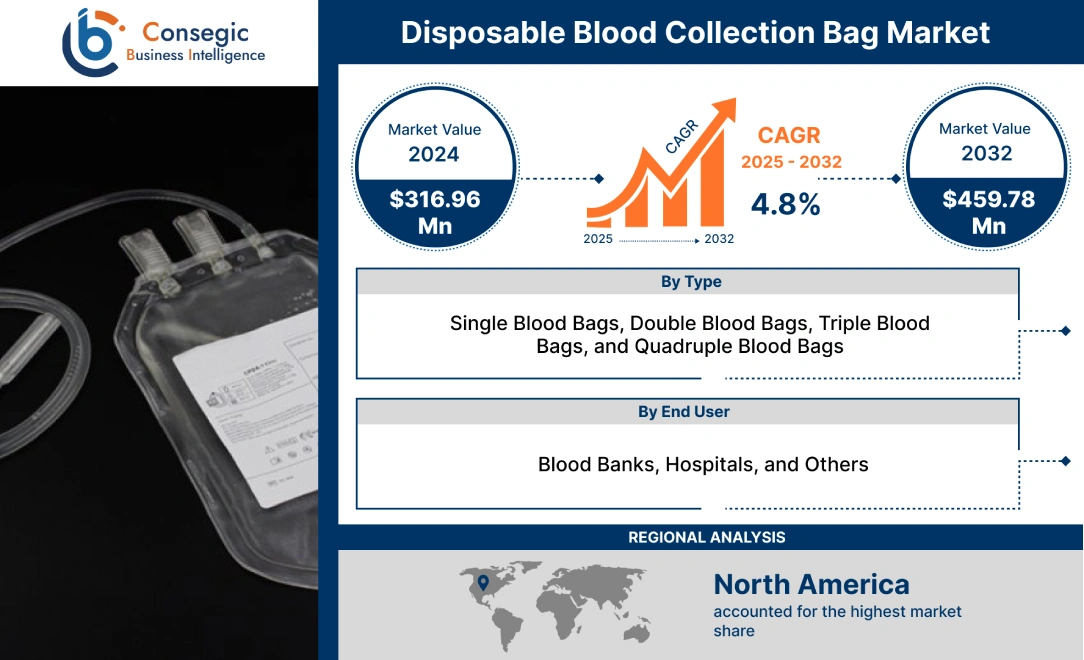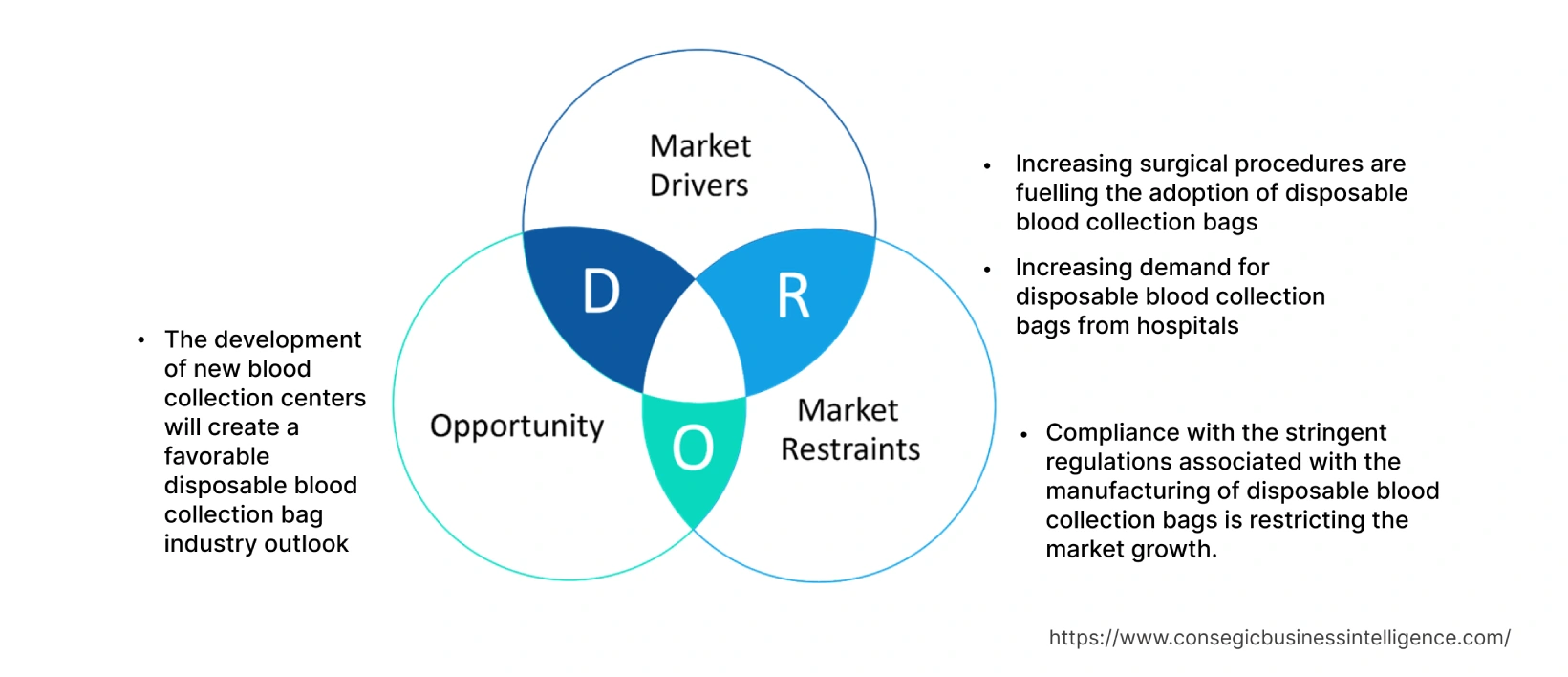- Summary
- Table Of Content
- Methodology
Disposable Blood Collection Bag Market Size :
Disposable Blood Collection Bag Market size is estimated to reach over USD 459.78 Million by 2032 from a value of USD 316.96 Million in 2024 and is projected to grow by USD 326.4 Million in 2025, growing at a CAGR of 4.80% from 2025 to 2032.
Disposable Blood Collection Bag Market Scope & Overview:
Disposable blood collection bags are a type of bio-medical product that is primarily employed for the storage and collection of blood & related components. The four major types of bags include single blood bags, double blood bags, triple blood bags, and quadruple blood bags. The prominent features associated with these bags are ensuring external sterility of the bags, being nontoxic, and strictly adhering to standard production, among others. As a result of the above features, these bags are considered safe, effective, and have superior transparency.
Furthermore, disposable collection bags accurately control blood components during the collection procedure. Also, blood collection bags are composed of medical PVC material so that the blood bag is unable to deform during the composition of blood components.
Disposable Blood Collection Bag Market Insights :
Key Drivers :
Increasing surgical procedures are fuelling the adoption of disposable blood collection bags.
The timely supply of blood can save lives and improve the health of patients during surgical procedures. As a result, disposable blood collection bags are utilized in surgical procedures for routine administration to ensure easy availability of blood in case of emergency during the operating procedure. The rise in surgical procedures at the global level is attributed to various determinants such as an increase in the treatment of diseases through operations, increasing prevalence of chronic diseases, and others.
- For instance, according to the Organisation for Economic Co-operation and Development (OECD), in 2019, the surgical procedures in South Korea were 689,919 surgeries, and in 2020, it was 702,621 surgeries, a year-on-year increase of 1.8%. Also, in 2020, the total number of surgical procedures conducted in Israel was 69,899 surgeries, and in 2020, it was 71,920 surgeries, an increase of 2.9%.
As per the disposable blood collection bag market analysis, the demand for these bags is increasing to ensure appropriate blood levels so that critical operations are safer for patients. This factor is accelerating the market.
Increasing demand for disposable blood collection bags from hospitals
Disposable blood collection bags are employed for the efficient handling of blood cells and plasma collection. In addition, these bags have safe, tamper-proof, and easy-to-open port covers to avoid contamination. As a result, these bags are an ideal solution for hospitals. The recently developed new hospitals are accelerating the growth in the demand for these bags to ensure efficient blood collection in case of emergencies.
- For instance, in October 2022, Purple Heron opened a new hospital in Jaipur, India. The hospital will provide facilities such as treatments, operations, and others for life-threatening diseases.
Therefore, in line with the new hospital launch, the adoption of these bags is increasing as the products are easy to fill without exposing the contents to air. This vital factor is propelling the disposable blood collection bag market demand.
Key Restraints :
Compliance with the stringent regulations associated with the manufacturing of disposable blood collection bags is restricting the market growth.
The global players involved in the manufacturers of disposable blood collection bags must compulsorily comply with various manufacturing standards. The prime focus of these regulations is to enable bags to be safe for the utilization of blood collection. Hence, the presence of various global standards for the manufacturing of these bags is restricting the market growth.
- For instance, according to the International Organization for Standardization regulation number ISO 3826, the plastic disposable blood collection bag must be tested for toxicity, sterility, and others.
Hence, analysis of market trends shows that the prevalence of the above-mentioned stringent standards associated with the manufacturing of bags is creating a bottleneck for the disposable blood collection bag market demand.
Future Opportunities :
The development of new blood collection centers will create a favorable disposable blood collection bag industry outlook.
Disposable blood collection bags are frequently deployed in blood collection centers to meet blood infusion emergencies. These factors, including the increasing investment in the development of blood collection centers, government initiatives, and others are accelerating the development of blood collection center infrastructure. This, in turn, will raise the demand for these bags in blood collection centers, thereby augmenting the market.
- For instance, in December 2020, Canadian Blood Services (CBS), opened a new blood collection center in Sudbury, Canada to collect blood plasma.
Thus, the market trends analysis depicts that the development of new blood collection centers will create lucrative disposable blood collection bag market opportunities in the upcoming years.
Disposable Blood Collection Bag Market Report Insights :
| Report Attributes | Report Details |
| Study Timeline | 2019-2032 |
| Market Size in 2032 | USD 459.78 Million |
| CAGR (2025-2032) | 4.8% |
| By Type | Single Blood Bags, Double Blood Bags, Triple Blood Bags, and Quadruple Blood Bags |
| By End User | Blood Banks, Hospitals, and Others |
| By Region | North America, Europe, Asia-Pacific, Latin America, and Middle East & Africa |
| Key Players | MacoPharma, Fresenius SE & Co. KGaA, Genesis BPS, Terumo Corporation, JMS Co. Ltd, Poly Medicure Limited, Narang Medical Limited, and AdvaCare Pharma |
Disposable Blood Collection Bag Market Segmental Analysis :
By Type :
The type segment is categorized into single blood bags, double blood bags, triple blood bags, and quadruple blood bags.
In 2024, the single blood bags segment accounted for the highest market share of the total disposable blood collection bag market share. The key features associated with single blood bags include optimum finish, high flow rates, sterilization, and others. These features ensure safer blood collection procedures. Single blood bags are available in various sizes, including 100 ml, 250 ml, 350 ml, and more. Thus, due to the above-mentioned features the adoption of single blood bags is increasing in hospitals and blood banks to ensure efficient collection and separation of whole blood, which, in turn, is accelerating the disposable blood collection bag market trends.
- For instance, in April 2021, the Ministry of Health and Family Welfare India announced the continuation of the development of 14 new AIIMS hospitals across the country which is scheduled to be completed by the end of 2025.
Thus, the analysis of segmental trends shows that the development of new hospital infrastructure will accelerate the demand for single blood bags to enable efficient blood collection, thereby favoring disposable blood collection bag market growth.
Furthermore, triple blood bags are expected to be the fastest-growing segment in the market over the forecast period, owing to the development of a new range of products. Triple blood bags are specifically designed to collect, separate, and store multiple components of blood (such as red blood cells, plasma, and platelets) in a single collection unit, improving efficiency in medical procedures and transfusions. The growing demand for blood components, particularly in hospitals and blood banks, is contributing to the increased adoption of triple blood bags. These bags offer several advantages, including reduced handling time, improved blood component separation, and more effective inventory management. Additionally, advancements in material technology, such as the use of safer, more durable plastics and anticoagulants, are driving product innovation in this segment. Thus, the segmental trends analysis, in turn, will drive the disposable blood collection bag market trends during the projected forecast period.
By End User :
The end user segment is categorized into blood banks, hospitals, and others.
In 2024, the hospitals segment accounted for the highest market share of 45.38% in the overall disposable blood collection bag market share. The presence of a slit in the bottom of the bag is ideal to hang the blood bag during the collection process. The rounded shape of the bag reduces the instances of loss of blood components during collection. Moreover, the bag has a long shelf life of 2 years. Thus, due to the above features, the utilization of these bags is increasing in hospitals as the prevalence of chronic diseases and operations is increasing. This, in turn, is driving the disposable blood collection bag market growth.
- For instance, in March 2023, construction work commenced on a Euro 30 million (USD 32.19 million) blood bank project near Mater Dei Hospital, in Malta. The development of the new blood bank will be completed by 2025.
Henceforth, analysis of segmental trends depicts that the ongoing development of new infrastructure for the blood banks will lead to expansion in the supply of blood, thereby creating a lucrative growth disposable blood collection bag market opportunity in the forecast years.
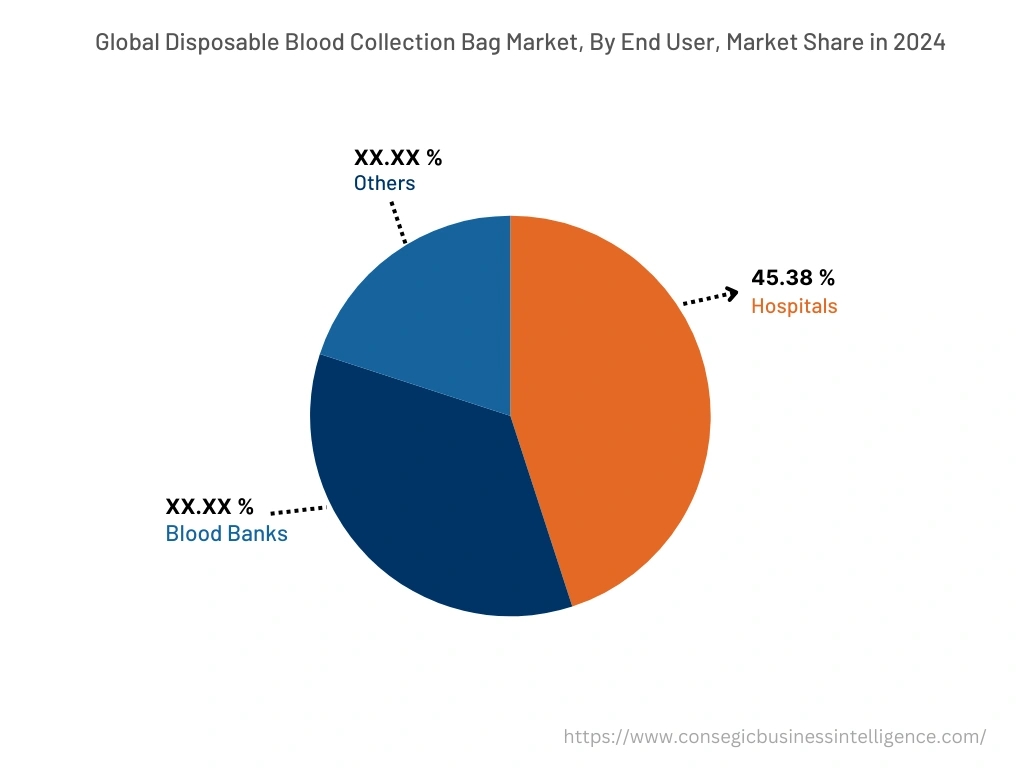
By Region :
The regional segment includes North America, Europe, Asia Pacific, the Middle East and Africa, and Latin America.
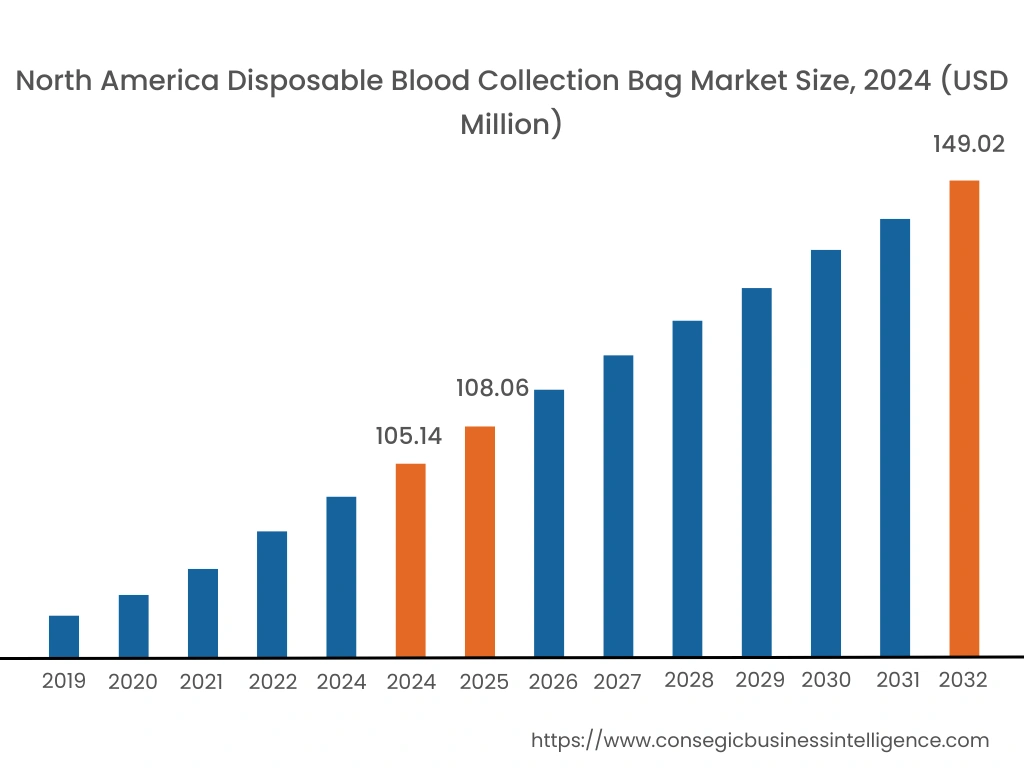
In 2024, North America accounted for the highest market share at 35.80% and was valued at USD 105.14 million, and is expected to reach USD 149.02 million in 2032. In North America, the U.S. accounted for the highest market share of 70.15% during the base year of 2024. This is due to the increasing awareness regarding the importance of blood donation and the growing number of blood donors particularly in the United States.
- For instance, according to recent statistics published by the Centers for Disease Control and Prevention, in the U.S., there are 11 million blood donors and more than 14 million units of blood transfused annually.
Hence, as per the regional trends analysis, the aforementioned factor is driving the disposable blood collection bag market expansion in the region.
Furthermore, Asia Pacific is expected to witness significant growth over the forecast period, growing at a CAGR of 5.4% during 2025-2032. The disposable blood collection bag market analysis shows that the growth is driven by the rising government initiatives in the Asia Pacific region to support blood donation and the increase in the number of blood banking units in developing nations, particularly in countries such as China and India.
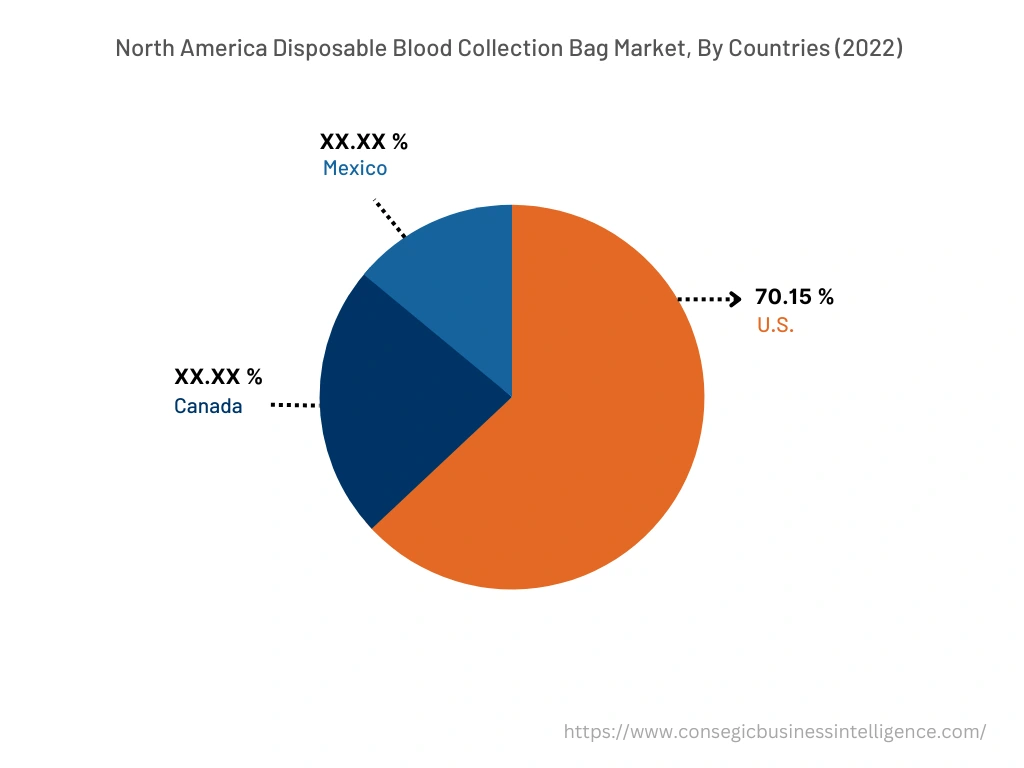
Top Key Players & Market Share Insights :
The global disposable blood collection bag market is highly competitive, with several large players and numerous small and medium-sized enterprises. These companies have strong research and development capabilities and a strong presence in the market through their extensive product portfolios and distribution networks. The market is characterized by intense competition, with companies focusing on expanding their product offerings and increasing their market share through mergers, acquisitions, and partnerships. The key players in the disposable blood collection bag industry include-
- Terumo Corporation
- MacoPharma
- Poly Medicure Limited
- Narang Medical Limited
- Fresenius SE & Co. KGaA
- AdvaCare Pharma
- Genesis BPS
- JMS Co. Ltd
Recent Industry Developments :
- In May 2019, Macropharma Corporation, based in the Philippines launched dual needle, an FDA NDA-approved disposable blood collection bag in the United States market. The primary aim of this launch was to increase Macropharma Corporation's presence in the United States market.
Key Questions Answered in the Report
What was the market size of the disposable blood collection bag industry in 2024? +
In 2024, the market size of disposable blood collection bag was USD 316.96 million
What will be the potential market valuation for the disposable blood collection bag industry by 2032? +
In 2032, the market size of disposable blood collection bag will be expected to reach USD 459.78 million.
What are the key factors driving the growth of the disposable blood collection bag market? +
Increasing surgical procedures are fueling the adoption of disposable blood collection bags.
What is the dominating segment in the disposable blood collection bag market by end user? +
In 2024, the hospital segment accounted for the highest market share of 45.38% in the overall disposable blood collection bag market.
Based on current market trends and future predictions, which geographical region will have the fastest impact on the disposable blood collection bag market's growth in the coming years? +
Asia Pacific is expected to be the fastest-growing region in the market during the forecast period.
